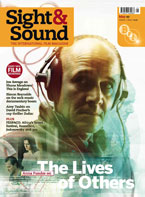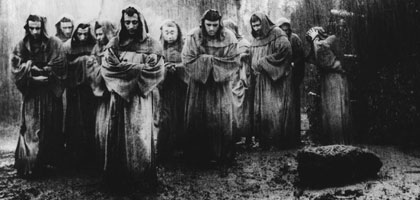Primary navigation


Roberto Rossellini was initially known as a neorealist, but was among the first to break towards a life-celebrating spiritual cinema with Francis, God's Jester. By Guido Bonsaver
Roberto Rossellini's Francis, God's Jester (1950) is one of those rare films that help define not only a director's philosophy, but a national trait and a cultural climate too. But let us focus first on the film. Its title suggests a biographical tale of one of Christianity's most popular saints, Francis of Assisi. Yet Francis, God's Jester is not a biopic and even less a historical film. Its first sequence introduces us to a group of friars walking slowly in the pouring rain. The person of St Francis is not singled out until, after a while, one of them addresses him by name. The ensemble nature of this initial scene continues throughout the entire film, to the point where other characters receive more screen time than the protagonist himself. It is not St Francis but the irrational spirituality of the early Franciscans that Rossellini intended to portray: their mad, frugal, self-humiliating lifestyle.
To some extent the film's style mirrors its content. A minimalism in mise en scène, soundtrack and camera movements had by then become a defining characteristic of Rossellini's film-making. But never had one of his films been so intentionally stylised or disrespectful of storytelling conventions. Its closest predecessor is Paisà (1946), in which the cruelty and horror of World War II are expressed through six unconnected episodes. In that film, after the stylistic and ideological simplifications of Rome Open City (1945), Rossellini developed a radical new approach, shocking in its crude view of the absurdity of war and its lack of moral-boosting stories and medal-deserving heroes.
During the shooting of Paisà Rossellini became acquainted with the Franciscan friars at a nearby monastery. There he experienced and brought to the screen the candid naivety still cultivated by the Franciscan order. In the resulting episode, it is absurd of the friars to fast in protest at the non-Catholicism of the American Jewish and Protestant chaplains. But it is an absurdity so strengthened by their meek method of action that it is impossible not to admire them. It was here that the project of Francis, God's Jester was born, and it was to that monastery and those friars that Rossellini returned when he decided to shoot the film.
The initial treatment of the script was 28 pages long and contained only 71 lines of dialogue. Rossellini had worked on it with Federico Fellini: together they had selected a number of biographical sketches from the anonymous medieval collection The Little Flowers of St. Francis. More importantly, they also used less hagiographical works focusing on other early Franciscan figures, such as the The Life of Brother Ginepro. Rossellini and Fellini intentionally shied away from any indication of a divine presence and for this reason the film disappointed Catholic circles. Francis and his followers emerge as worshippers of life, of the natural world: water, earth, fire and all creatures great and small, from birds to humans. This pantheistic vision leaves to God the role of some undefined, almost unnecessary being. It is the desire of the Franciscans to be at one with everything that makes them 'insane': talking to trees and birds, giving away all their clothes, hugging and kissing a leper.
It is in this light that the second part of the film's title, 'God's Jester', acquires its full meaning. The Franciscans are the extreme exponents of a joie de vivre that enourages them to venerate and thank the whole world around them - and they have fun doing it. Perhaps the least-recognised aspect of the film is the lightness and irony with which these friars walk the earth, and the lightness and warmth with which Rossellini portrays them. We should be cautious before elaborating too fully on spirituality, religious faith and philosophical asides transformed into cinematic technique. Rossellini was too instinctive a director to dwell on how to turn his thoughts into a moving image. This film is a homage to child-like wonder and selfless altruism, and it's not surprising the show is almost stolen by Brother Ginepro and Brother John the Simpleton, the most naive and divinely mad characters. Both of them lack the self-awareness and charisma of Francis of Assisi; they are a kind of saint-next-door whose normality and stolidity are reassuringly laughable. The friar playing the perennially confused John the Simpleton was apparently the same in real life, so after failing to have him learn his lines by heart Rossellini let him improvise. This is Rossellini at his best.
It is important not to leave Fellini out of the equation. The blend of innocence and irrationality displayed here can be found in a string of Fellini characters. Giulietta Masina, his lifelong companion, impersonated some of them, starting with the poor Gelsomina of La strada (1954). Equally key to Fellini's film-making are the mad but good-hearted prostitute prowling the beaches of Rimini in 8 1/2 (1963) and Amarcord (1973), the uncle who climbs to the top of a tree and shouts "I want a woman!" (Amarcord), or the mad poet talking to the dead through water wells in La voce della luna (1990). Roberto Benigni played the last part, and his films seem to have brought this type of dysfunctional character into the 21st century.
Is this inclination towards populating the cinematic landscape with lovable, mad people indicative of a national characteristic? Of course not; and yet... Interviewed in 1951 while shooting Europa '51, Rossellini ventured into a piece of anthropological profiling: "The ability to see both sides of man, to look at people with benevolence, seems to me an attitude exquisitely Latin and Italian... Christianity doesn't depict everything as good and perfect. It recognises mistakes and sin, but also admits that salvation is possible... In our civilisation, Latin and Christian, we do not enshrine truth. We are full of irony and scepticism; we keep on searching for truth."
Like all generalisations, this comment can be taken to pieces in no time. It is also dangerously close to that old saying 'italiani brava gente' (Italians are good people) with which historical crimes have been denied on the assumption that Italians are too nice and disorganised to do anything truly evil. And yet it is tempting to say that Rossellini was tapping into a kernel of truth. Perhaps it is not so trivial to suggest that a child-like vision of reality - innocent, open-smiled and irrational - recurrently finds its way into Italian cinema. It does not necessarily portray what Italians are really like, but perhaps it is a projection of how they would like to be and to be seen. While shooting Paisà Rossellini did not stop driving his Cadillac and his Ferrari, nor did he dismiss the nine full-time employees who looked after his and Ingrid Bergman's household needs. Nonetheless, he was drawn to the community of Franciscans enough to build a film around their joyful madness.
And he was not alone. At around the same time the other father-figure of Italian neorealism, Vittorio De Sica, broke away from the genre's restrictive vision. If Rossellini took refuge in medieval novellae, De Sica produced a fairy tale. Miracle in Milan (1951) was released only a few months after Francis, God's Jester and similarly revolves around the figure of a madly innocent protagonist, Totò, whose only goal is to help create a world "where the words 'good morning' really mean 'good morning'." Barmy. Mad. That is how the film was received at the time, and yet its disarming naivety has inspired scores of other directors. Among them is Steven Spielberg, who confessed to creating the logo of his production company Amblin Entertainment and the famous scene in E.T. with the alien flying on a bicycle in homage to Totò's final flight on a broomstick over Milan's Duomo.
This sudden and near-simultaneous change of approach by Rossellini and De Sica is an intriguing coincidence. Perhaps the desire for purity and innocence was a natural reaction after the horror and depression of the war years. Perhaps it was linked to the fear that the world was about to descend into a new era of nuclear terror. Closer to home, it was certainly an act of rebellion against the stylistic straitjacket imposed by neorealism. But it might also have been related to the fact that after the elections of 1948, Italy was fast becoming a more hedonistic, Americanised society. It might have been a cry for help. And it was one that struck a chord in subsequent generations.
Fellini's La dolce vita (1960) should be seen as a film about the loss of innocence and values in those years of unexpected richness. It is ironic to think that for so many the film is thought to be about the beautiful life of 1950s Rome. Perhaps Fellini should have kept the discarded opening scene that showed the joyful swimming of a group of friends around their billion-Lira motorboats. It was a perfect picture of the hedonistic jet-set life until one of the guests on board dropped a cigarette into the water on to the pool of petrol spilling from a leaking tank. The scene was supposed to end with the horrifying screams of bathers burning alive but Fellini cut it and went for subtler tones. Yet the social critique and search for purity remained: hence Marcello and the girl in the final beautiful scene are unable to hear each other, unable to communicate. La dolce vita traces the end of any utopian idealism. And still, the urge remained.
Rossellini's Francis, God's Jester gave shape to an aspiration other directors embraced. Benigni made it his own with a madly innocent character thrown into the horrors of Auschwitz in Life Is Beautiful (1997). In our frail new century of globalisation and world-scale environmental fears, perhaps some other director will produce a cinematic argument in favour of a simple, frugal, all-loving, all-respecting life. Barmy. Mad. And yet so indispensable.